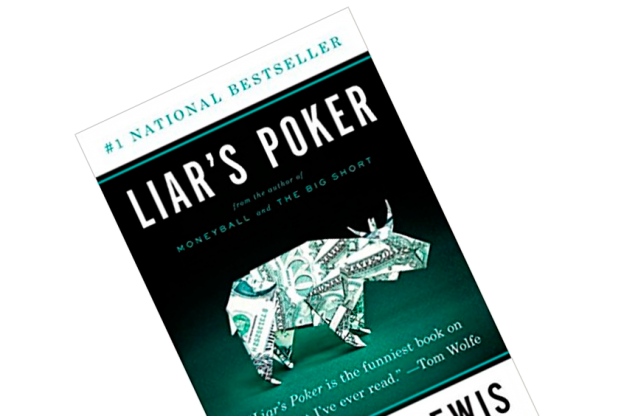Abstract
- Liar’s Poker is game that was prevalent on Wall Street in the 70s and 80s. In a five-man game, each participant holds a $100 bill, and he/she needs to guess how “many of a kind” (i.e. twos, fours, sixes) there are on all five bills’ serial numbers combined. Eventually, someone will say: “Nah, there are not that many sixes”, and thus pull the plug on the game. If there aren’t indeed that many sixes, he wins; if there are, he looses. In one memorable challenge, $10 million dollars were on the line.
- Each time an impactful event takes place, you need to quickly ask: “What if?” Think fast, think ahead, and you might be able to earn a buck on potatoes (cf. story below).
The Wolf of Wall Street is probably the only book that even come close to being as funny as Liar’s Poker. The book is an insanely humorous reminiscence of Michael Lewis’ days as a Salomon Brothers trader in the 70s and 80s when the US bond market rallied immensely. Michael describes the ruling culture in the industry and the financial products they invented to drive commissions. It’s disturbing, no doubt, but the book is very enjoyable.
Liar’s Poker: Lies on Steroids
Liar’s Poker was a game that Salomon Brothers’ traders engaged in on a daily basis. The insanity of the game captures the culture and excess wealth that dominated Wall Street in this era.
The game is simple. Any trader could walk up to another bunch of traders and shout “Liar’s Poker, $100”. Each one was then compelled to pull up a hundred-dollar bill, and let the game begin. Each participant would take a look at his or her bill’s serial number, which might say “A12345678B”. You would then bet on how many of a ‘kind’, e.g. twos, fours or nines, there are on one’s own bill plus the others. At some point someone will say: “Nah, there are not that many sixes”, and thus pull the plug on the game. If there aren’t indeed that many sixes, he wins; if there are, he loose and thus opts out. The game continues as such until one lucky soul stands back with the other fools’ money.
The most insane round of Liar’s Poker is narrated in chapter 1. The CEO, John Gutfreund, steps into the King of Liar’s Poker’s office, John Meriwether. “Liar’s Poker, $1 million dollars, no tears”, said Gutfreund. Meriwether, though a superior Liar’s Poker player, was frightened to death; he knew that Gutfreund weren’t kidding. In a high-risk gamble to opt-out of this proposed bet, Meiwether said: “If we’re going to play for that kind of money, we might as well do it properly. $10 million dollars.” Gutfreund, rich as he was, considered it for some time. But eventually, he surrendered: ”You’re insane”, he said, and leaved the room.
Inventing financial “products” (or trash, really)
As mentioned, the bond market was booming. Yet, at some point there weren’t more bonds to trade, and volumes declined. As the traders and executives’ commissions were bound to the amount of bonds sold, this fact was unacceptable. Hence, they needed to create a marketplace by inventing financial products.
hen Lewis Ranieris was hired at Salomon Brothers, he initiated an avalanche of misery. Briefly put, Lweis needed wanted to create a product that could be sold to investment banks and pension funds. Hence, he had to create large blocks of something that would ‘make a dent’ in funds with billions of dollars. He came up with the somewhat innovative idea of bundling a lot of terrible mortgages – which couldn’t be bought and sold otherwise – together, and thus making them “secure” (based on the logic that one substandard borrower is a risk while a lot of them aren’t). These derivative packages were called CMOs (collateralized mortgage obligations)
These derivatives were indeed horrifically poor products, only designed to line Salomon Brothers’ own pockets. Yet, the naïve institutional investment managers took the bait – which they shouldn’t have. They ended up being the hot potatoes that were passed along to the next sucker.
You know what’s the scariest thing? These derivatives were the essentially the exact same explosive that caused the 2007/2008 crash. The differences between the two era’s crises: the scale, and the name of the product. Rather than CMOs, they were re-labelled to CDO (credit default obligations), because it wasn’t only mortgages this time around, but all kinds of shady debt. However, that’s a tale for another time.
What if?
One of the more instructive episodes of the book is an exchange between Michael and his colleague, Alexander. Alexander was a top trader, one of the few Michael characterizes as intelligent in the Salomon Brothers madhouse. Alexander taught Michael to always ask the question: “What if?” For instance, when the Chenobyl catastrophe hit, Alexander dialed Michael up. He reasoned that if the demand for nuclear energy fell, the demand for oil had to increase. He thus hurried to purchase oil futures in the expectation that oil prices would spike. Minutes after, he called again, and shouted: “Buy potatoes!” Shortly thereafter, the media expounded that “European agriculture would be infested as a result of the incident”, hence driving up the demand for uninfected American vegetables. In both instances, Alexander was right, and he earned a small fortune. The morale? Think fast, think ahead.
Liar’s Poker beautifully describes the egocentric culture that prevails on Wall Street. The way the book describes the complete lack of etiquette (for instance, one of the Salomon Brothers traders lit up a small fire in a sushi restaurant to cook his fish while having a business dinner with a Japanese trader) mixed with the Michael’s reflections on how the environment corrupted his soul convinces me of one thing: Watch out, and be very skeptical of what Wall Street is trying to convince you of. They usually have but one interest: themselves.

One thought on “Book Summary of Liar’s Poker”